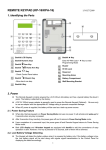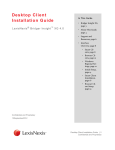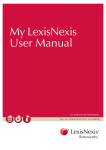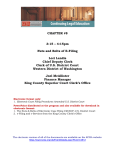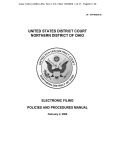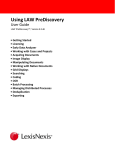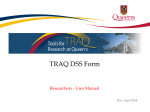Download Document Vetting
Transcript
Methods of Effective Document Selection in Law Firms Chad A McAllister LexisNexis Technology Specialist © 2004 LexisNexis trademarks used herein are trademarks of their respective owners. INTRODUCTION The saying “garbage in, garbage out” is often familiar to computer users. It means that computer systems are only as good as the information provided to them. The saying is a reminder of how important proper document selection is for LexisNexis® Total Search or any document retrieval system a firm chooses to deploy. Document retrieval solutions provides the most worth to their users when they contain the majority of the firm’s documents with usable knowledge and few low-value documents. This allows users to quickly find firm documents that are truly useful and not waste their time. Because this is so important to a successful LexisNexis Total Search installation, a LexisNexis Content Consultant is assigned to each deployment. The responsibility of the Content Consultant is to help the firm create a strategy and process for selecting documents. This paper has three sections. The first section provides a discussion about document selection approaches, covering suggestions and guidelines for identifying documents for inclusion in a document retrieval system. The next section presents models for an ongoing document vetting process. The final section provides a brief overview of LexisNexis Total Search. For more information on the Total Search system, a separate white paper as well as a user manual is available. DOCUMENT SELECTION—THE BIG PICTURE The general objective of selecting documents for a document retrieval system is to identify those documents that contain “usable knowledge”. Usable knowledge means that people in the firm could find the content of a document valuable in the future. Briefs, motions, precedent documents, and reports are examples of documents that could contain usable knowledge. Time sheets, fax cover sheets, and billing lists are not considered usable knowledge. Only a fraction of the documents in a firm’s document management system (DMS), or file structure, are likely to contain usable knowledge. A good rule of thumb is to expect 5 to 10% of the total number of documents in a DMS to be those that meet the firm’s definition of usable knowledge. An iterative process of identifying documents with usable knowledge is frequently followed. The process, depicted in the figure below, can be thought of as a funnel. At the top of the funnel are all of the documents in a firm’s DMS. An initial document selection criteria is applied to identify a smaller number of documents likely to meet the firm’s definition of usable knowledge. A refinement of the selection criteria may be applied to eliminate less useful documents, resulting in an even smaller number of documents selected. Although this process can continue as many times as necessary until the final set of documents contains a maximum of usable knowledge documents and a minimum of unusable documents, one or two iterations is often sufficient. All Documents in DMS 100% of available documents Initial Selection Criteria Candidate Usable Documents Candidate Usable Documents Selected Usable Documents 5 – 10% of Available Documents This process is performed before installing LexisNexis Total Search. Once LexisNexis Total Search is in use, if documents are found that should not be accessed through Total Search, the selection criteria can be altered to eliminate these documents or they can be manually removed. After the initial loading of documents, very little is typically required to maintain a useful document collection. The major steps taken by LexisNexis® Content Consultant in selecting documents 1. Create initial criteria for “usable knowledge”. Users should be asked to describe the characteristics of documents they find most useful. This is often based on the profile of the document, such as titles, practice groups, document type, keywords, or author. 2. Conduct document analysis. The selection criteria is translated to database queries used by LexisNexis Total Search to select documents. Then, reports are created analyzing the documents matching the criteria. The number of documents matching the selection criteria should be approximately 10% of the total number of documents available. 3. If necessary, refine document selection criteria. Look for obviously useless documents that could be removed from the candidate document collection. Examples include fax cover sheets, document templates with no content, files titled “junk, temp, delete, ....”, documents by certain authors or practice groups, etc. 4. Configure manual vetting. Once the system is in use, documents may be discovered that should be removed or documents may need to be added that did not meet the selection criteria. A means to manually add or remove documents from the system is helpful. This can be accomplished by modifying the document profile(s) provided by the DMS. DOCUMENT SELECTION APPROACHES The firm likely already has a good deal of experience identifying documents with usable knowledge. A combination of the approaches below is typically deployed by the LexisNexis Content Consultant to select documents. DOCUMENT PROFILE APPROACH This approach is always used to create a document selection criteria. Documents are identified based on their profile tracked by the document management system (DMS) or other flat file document sources. Several fields are typically available, depending on the DMS and its configuration, including: • Document type (e.g., Brief, Motion, Research, …) • Application (e.g., Word Perfect, MS Word, Adobe PDF, …) • Practice group • Matter name • Document name • Author name • Approximate number of characters in document • Creation date • Last edited date When considering documents with usable knowledge, common questions to ask include: • What document types are typically applied by users of a document retrieval system? • Is there a catch-all document type, such as “misc” or “other” that is frequently used for valuable documents? • Which practice groups should be included? • What application types should be included—Word Perfect®, Microsoft® Word, etc? • Should documents from all authors be included, or will some authors’ documents be excluded? • Are documents to have a minimum or maximum length? For example, exclude any documents shorter than approximately one page. • How old can documents be and still be included—e.g., 5 years, 7 years, etc.? • How recently can a document have been edited? Recently edited documents may not yet offer value for others to use because they may not be finished. Documents not edited in the last 45 days are likely to be complete. MANUAL VETTING APPROACH In addition to automatic document selection, manual vetting is also often used. This allows users, administrators, or other designated people to manually add or remove documents. Manual vetting can be enabled from the DMS document profile form by adding an indicator field to the form. The field can be labeled appropriately for the firm (e.g., “Include in Total Search”). A DMS user can check the field or uncheck it when saving the document. A check indicates that the document will be added to the system while an uncheck indicates that the document will be removed from Total Search. Adding and removing is automatically accomplished on a scheduled basis by LexisNexis Total Search and typically occurs every night but may be scheduled to occur more or less frequently. BRIEF BANK APPROACH If the firm has created a brief bank in the past, its contents should be included in LexisNexis Total Search. Further, the process used to create the brief bank may offer value in creating a document selection criteria and those involved with the brief bank should be consulted. Examining the documents in the brief bank may uncover similarities that can be used in the selection criteria, such as common authors, document types, or keywords. DOCUMENT CONTENT APPROACH The full text of a document contains additional intelligence that could be exploited in a document selection criteria. One example is documents that contain case citations. Such documents are good candidates for LexisNexis Total Search because it can cross reference documents based on citations. TYPICAL VETTING PROCESS MODELS After the system is initially configured with documents, additional documents will be created that should be added. Or, documents will be found that should be removed (because they do not contain usable knowledge, were accidentally added, etc.). Firms typically use the Fully Automated process with one of the other processes, tailoring it to their needs. FULLY AUTOMATED This process requires zero manual intervention from anyone. The document selection criteria used for initially configuring the system continues to be used. The system scans the DMS on a scheduled basis looking for changes to the document collection. If a document is found that should not be included, it can be removed using the manual vetting approach previously described. The advantage of this approach is that no human intervention is required to consider what documents should be included. Further, the document selection criteria can be occasionally modified to reflect the changing needs of the firm. The disadvantage of this approach is that valuable documents not meeting the selection criteria will not be included. CENTRALIZED A centralized document vetting process requires one person or group to be responsible for administering documents into the system. Consider two scenarios: (1) the need to add a document and (2) the need to remove a document. If a document is written that clearly provides value to others in the firm, it should be added to the system. If it meets the document selection criteria, it will automatically be included. Otherwise, it must be manually added. In a centralized model, the author or an editor would notify the person or group responsible for documents to be added. This could be accomplished by e-mailing the document number and requesting it be included. Removing a document follows the same process, with someone notifying the central administrator that a document should be removed. In both cases, it is up to the central administrator to add or remove documents. They use a special document profile that they have access rights to. The advantage of this approach is that it allows for a review process to be put in place. A document cannot be added before it is reviewed and its usable value is assessed. The disadvantage is that adding and removing documents is controlled by one person or group, which may slow the rate of document vetting or even cause it to be ignored (reminiscent of many firms’ experiences with maintaining brief banks). DE-CENTRALIZED As opposed to a centralized administrator, the de-centralized model can be used to allow anyone with appropriate user access to add or remove documents. Again a special document profile is used, but access to the profile is provided to many if not all DMS users. Using this process, individual document authors or editors have control over documents going into or removed from the system. The advantage of this approach is that anyone with the proper access rights can be allowed to add and remove documents, enabling individual authors, editors, or users of documents to control what documents are inputed. Documents can be rapidly added or removed because no review is required. The disadvantage of this approach is that it does not allow for documents to be reviewed and some documents of questionable value could be added or very valuable documents could be accidentally or purposefully removed. PRACTICE GROUP HYBRID A hybrid of the centralized and de-centralized processes may be created, often occurring at the practice group level within firms. In this process, each practice group has a centralized document administrator that can add and remove documents. Practice group members contribute recommendations to their administrator. This has the advantage of allowing a practice group control over the documents that are most valuable to their group while also providing a review. The disadvantage is that the review must occur and if the reviewer does not get to requests in a timely manner, the quality of the document collection may erode. SUMMARY Selecting documents for inclusion in LexisNexis Total Search is a straightforward process, both for the initial configuration of the system and on-going use. A selection criteria can be created in a few hours with a minimum of firm resources required. Once the selection criteria is in place, it continues to be the primary means of automatically maintaining a valuable document collection. It can also be augmented with a manual vetting process that is either centralized or decentralized in nature. TOTAL SEARCH OVERVIEW LexisNexis® Total Search is a Web browser-based application that expands the boundaries of the LexisNexis® Total Research System by letting a user search at www.lexis.com and within their law firm’s internal work product simultaneously—fully utilizing its most valuable assets – the intellectual property and collective expertise already residing within the firm. Or, users can use the advanced searching capabilities of Total Search to search only the firm’s internal document collection. Once LexisNexis® Total Search is installed on a firm’s network, users can quickly and easily find relevant work product, including existing pleadings, depositions, memos and motions written by in-firm experts, together with trusted information from LexisNexis—with one search through the familiar user interface of www.lexis.com. Researching using LexisNexis Total Search is essentially the same as researching at www.lexis.com. The difference is that now a user can securely and confidentially search their firm’s internal work product when searching any LexisNexis database or file. Users can then easily review and navigate between both internal and LexisNexis results. LexisNexis Total Search also identifies, correlates, and links case citations appearing within internal work product and LexisNexis search results. These citations are noted, and access to the internal work product is provided, through a “correlation” icon appearing next to a particular case or code citation within an internal document result, LexisNexis full-text document or in a LexisNexis cite list. Further, all case law and statutes are given appropriate Shepard’s® Signal™ treatment, with real-time links to the full Shepard’s® report. LexisNexis, the Knowledge Burst logo, and Shepard’s are registered trademarks, and Shepard’s Signal is a trademark of Reed Elsevier Properties Inc., used under license. It’s How You Know is a Trademark of LexisNexis, a division of Reed Elsevier Inc. © 2004 LexisNexis, a division of Reed Elsevier Inc. All rights reserved. LON00668-0 1104







